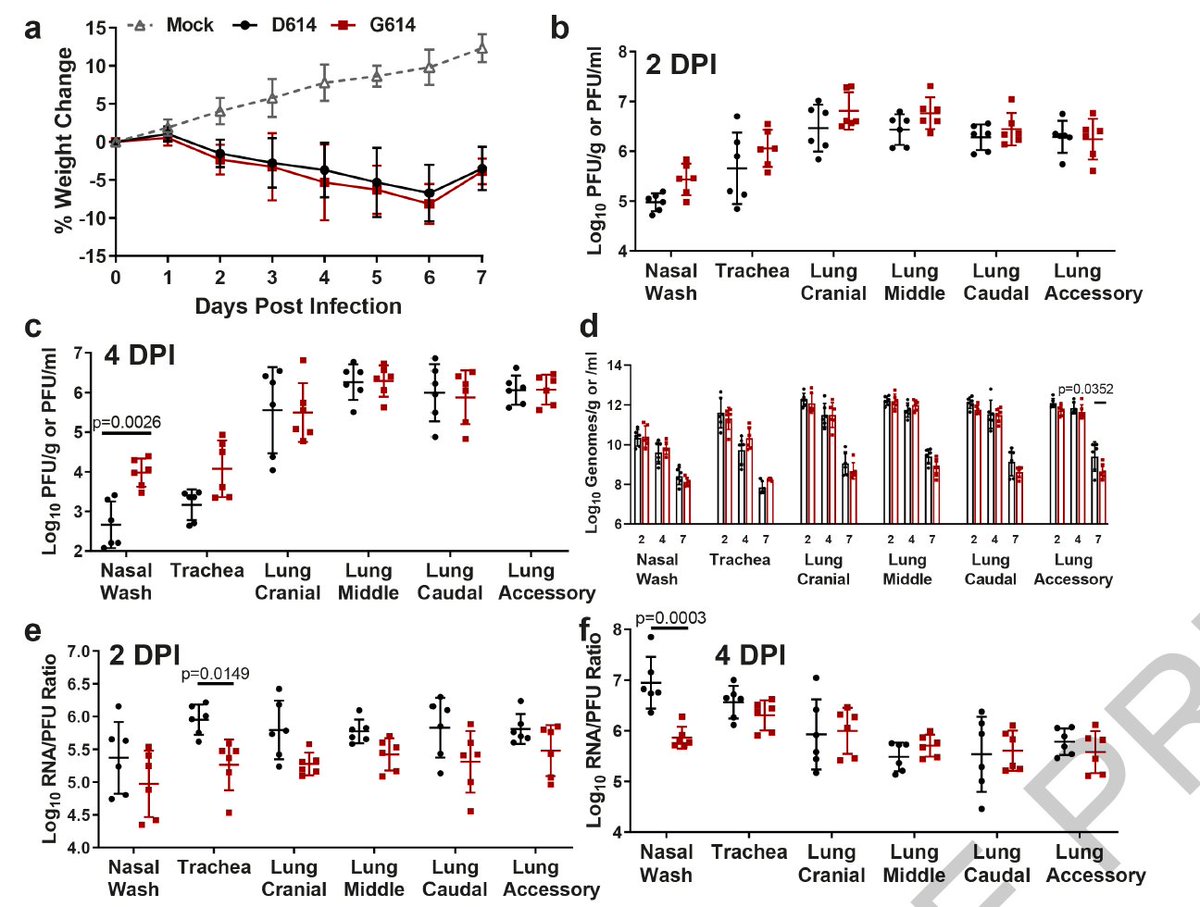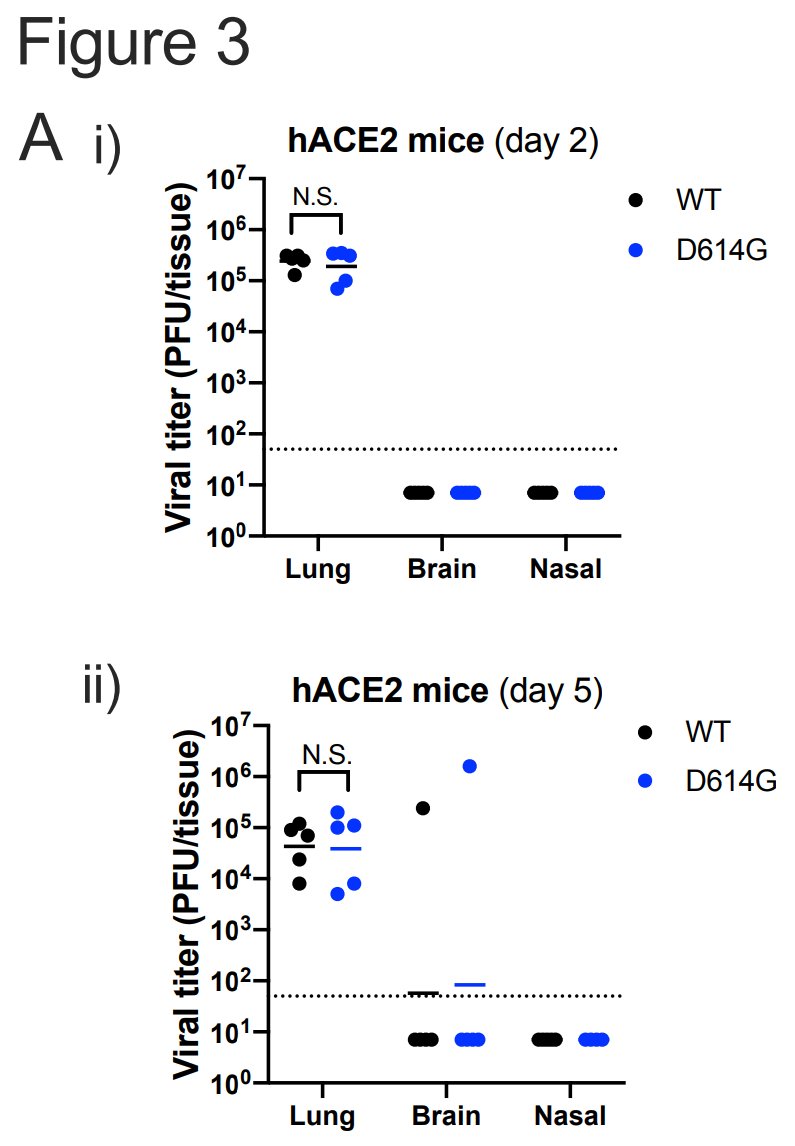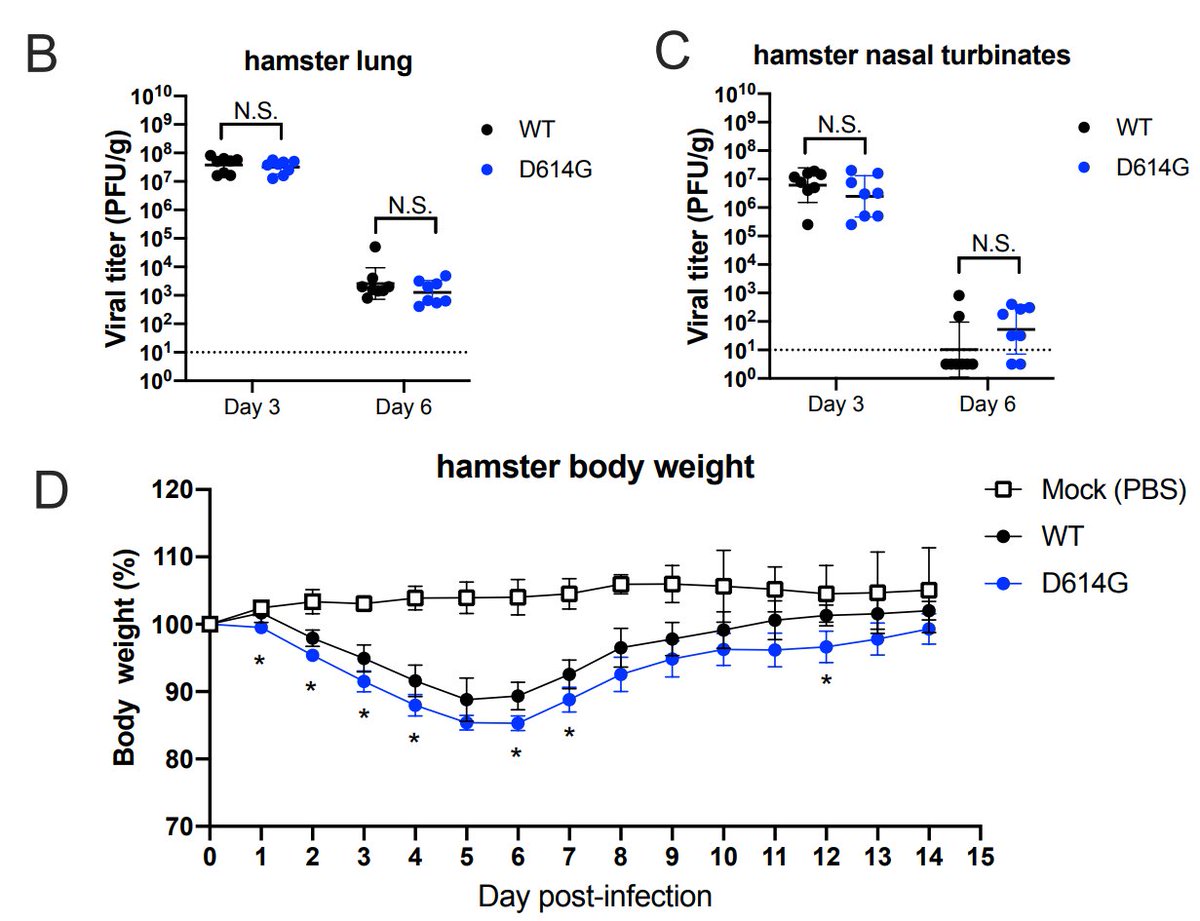
On the topic of controversial SARS2 mutations. I've been delaying a thread on D614G because I think people watching US elections do not have the emotional/mental bandwidth to deal with complex analyses.
But it looks like the election results won't be known for days, so...
But it looks like the election results won't be known for days, so...
How does the D614G variant affect public health measures, vaccines, and therapeutics?
As far as we know - there is no impact.
The paper claiming that it increases transmissibility, says: "no significant correlation found between D614G status and hospitalization status"
As far as we know - there is no impact.
The paper claiming that it increases transmissibility, says: "no significant correlation found between D614G status and hospitalization status"
Furthermore, the D614G mutant has been one of the earliest variants in each country (except China and a few exceptions) since the beginning - it's not like this strain suddenly appeared later in the pandemic - covered in this thread:
https://twitter.com/Ayjchan/status/1309497827521900550
Recent work has also suggested that this mutation does not reduce the efficacy of vaccines and antibodies developed against the parent D614 variant nature.com/articles/s4158…
Notably, evidence for the increased transmissibility of this variant is so tenuous that @CellCellPress co-published, in August, an article alongside the Korber et al. paper reinforcing that we just don't know if D614G dominated by chance or by selection. pubmed.ncbi.nlm.nih.gov/32697970/
In September, @NatureNews published this article: "many scientists say there remains no solid proof that D614G has a significant effect on the spread of the virus" nature.com/articles/d4158…
The one epidemiological study that found D614G could be more transmissible was by @CovidGenomicsUK but they're not sure whether increased transmissibility is due to the mutation or that average age of G614 carriers was ~5 years younger than D614 carriers.
https://twitter.com/Ayjchan/status/1291836217391288321
What about the claims of increased viral loads in patients carrying the G614 variant? Maybe there is a slight difference, but this data has not been adjusted to account for age, hospitalization, date of sampling etc.
https://twitter.com/Ayjchan/status/1279070685575479300
Scientists have tried to find evidence of significantly more transmissible variants of SARS2 but: "Not all analyses found a conclusive signal for D614G, and effects on transmission, when detected, appeared relatively moderate"
biorxiv.org/content/10.110…
biorxiv.org/content/10.110…
Early experiments (pseudotyped viruses) trying to understand whether the D614G mutation affects the ability of SARS2 to infect human cells imo revealed that the current approach of SARS2 virus production and infectivity assays may not accurately reflect real life biology.
Using this system, the virus actually performed 10x better when it lost a feature (the S1/S2 FCS) that is essential for its ability to infect different cell types and cause severe disease. biorxiv.org/content/10.110…
Similarly, scientists noticed that in the conventional virus production system using Vero cells (monkey kidney cells): "the G614 variant is ∼2.5-fold more resistant to cleavage in the host cell than the D614 variant"
biorxiv.org/content/10.110…
biorxiv.org/content/10.110…
This is an observation that is worth keeping in mind. The production system (1) favors a form of the virus that is missing a highly conserved feature in human virus isolates (the FCS) + (2) gives you D vs G614 virus in different states possibly due to traits of the producer cell.
Personally, I would've been convinced if the producer cells were from the intestine or respiratory tract. But as it is, all of these experiments in the lab use viruses made by kidney cells. I don't know how likely it is that virus from your kidneys are spreading to other people..
At this point, a layperson may ask: why are scientists using kidney cells to make viruses?
These kidney cells (Vero, HEK293) are really easy to work with and use for massive virus production.
Other cell types tend to be challenging to grow, not to mention produce viruses with.
These kidney cells (Vero, HEK293) are really easy to work with and use for massive virus production.
Other cell types tend to be challenging to grow, not to mention produce viruses with.
Finally, a couple of groups tested D vs G614 SARS2 viruses in hamsters. But these viruses were still produced from kidney cells so you need to keep in mind that the D vs G viruses are potentially in different states when introduced to hamsters.
nature.com/articles/s4158…
nature.com/articles/s4158…
The authors reported: "G614 virus retained higher infectivity than the D614 virus at all temperatures, suggesting that the D614G mutation may increase the stability of SARS-CoV-2."
We don't know whether this is due to the exact mutation or that they were produced differently.
We don't know whether this is due to the exact mutation or that they were produced differently.
The scientists intranasally infected hamsters with the same amount of D vs G virus (despite knowing that G virus produced from kidney cells is likely more stable), and they actually did not see a significant difference in the hamsters. I better break this figure down. 

The authors measured the weight change (no difference), amount of infectious virus on day 2 (no statistical difference; Fig 2b) and day 4 (difference in nasal wash but not trachea or lung; Fig 2c)...
The authors were unsure if the slight difference was due to host-to-host variation, so they did a competition assay - introducing equal amounts of each virus into the same hamster intranasally. 

Meanwhile, a parallel study tested D614G in both humanized (hACE2) mice and hamsters, finding no significant differences in mice in terms of amount of virus in lung, brain, and nose on day 2 and day 5. biorxiv.org/content/10.110… 

In hamsters, they also did not see any significant difference in amount of D vs G virus in the lung or nose on day 3 and day 6. Although they observed slightly more weight loss in D614G infected hamsters. 

Their version of a competition assay was to have pairs of hamsters set up to see how fast an infected hamster (with D or G virus) would infect another hamster. 

They found that both D and G variants transmitted to similar extent by day 4 and day 6 but the G variant seemed to transmit earlier (by day 2). 

What these animal data collectively suggest is that there could be some increase in the amount of D614G virus in hamsters in the early phase of infection, but it is unclear whether this is due to the actual mutation or is an artifact from giving animals virus made w kidney cells.
If you've made it this far down the thread, congratulations.
Ultimately, it is still not clear (yet) whether D614G is more transmissible in humans or not, but it does not seem to affect our vaccines, therapeutics, or our public health policies to fight the spread of COVID.
Ultimately, it is still not clear (yet) whether D614G is more transmissible in humans or not, but it does not seem to affect our vaccines, therapeutics, or our public health policies to fight the spread of COVID.
What does this mean for someone who has the D614G variant. Basically nothing. It's not that you got a significantly more transmissible strain. It's not that vaccines won't work as well on you. And, it's not that your country fared worse against covid because of this mutation.
• • •
Missing some Tweet in this thread? You can try to
force a refresh


